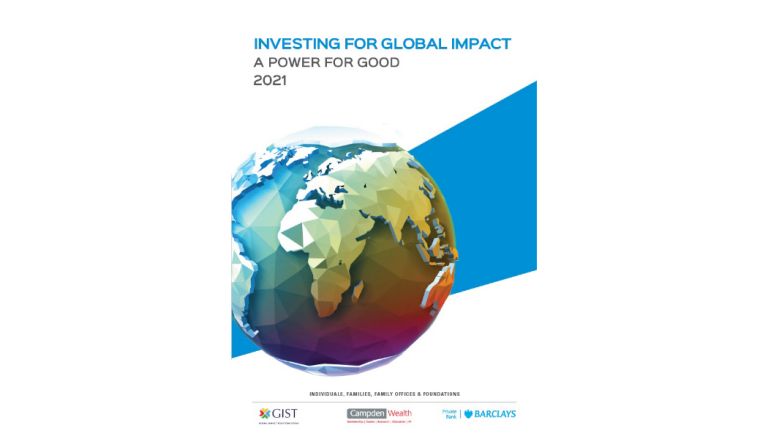
Investing for Global Impact
The global appetite for sustainable investing is growing at a phenomenal pace. Find out how investors are influencing tomorrow in the 2021 ‘Investing for Global Impact’ report.

03 November 2021
8 minute read
By Damian Payiatakis, Head of Sustainable and Impact Investing, Barclays Private Bank
This is the third article in a new series supporting the release of the 2021 edition of ‘Investing for Global Impact: A Power for Good’. For more information, please click the links at the bottom of the page. Please note: The article does not constitute investment advice.
The world’s window of opportunity to prevent climate breakdown is narrowing. Tangible progress is needed. Progress isn’t abstract. It’s quantifiable through carbon, climate, and environmental data.
For investors, knowing how close, or far, you are from your climate ambitions is critical for your investments, and your portfolio’s contribution to the global effort. This is the role of impact measurement, reporting, and monitoring – collectively called impact management.
In the final instalment of our series on transitioning to a climate-ready portfolio, we provide perspective on how to manage your portfolio’s climate impact. Having first looked at setting your climate ambitions and then turning them into portfolio action, it’s as critical to quantify, and act, on the impact your portfolio is, and will be, making.
As previously, our aim is to provide general explanations of how impact management works and its potential value to you.
Impact essentially describes a change, positive or negative, intended or unintended, on the real world. Impact management is an ongoing and iterative process of measuring, assessing and improving your portfolio’s impact on people and planet.
New to many private and institutional investors alike, the impact management field is evolving, and improving, rapidly. According to the 'Investing for Global Impact: A Power for Good' 2021 report, 68% of respondents see impact management as a significant challenge, but encouragingly, 98% have seen progress, with 49% seeing “significant progress”.
There is not yet a universal approach to impact. But, by convening over 2,000 practitioners in a global forum, The Impact Management Project1 has developed a consensus around five dimensions of impact. These are a useful framework when thinking about impact:
Here we outline how to think about measuring, assessing, and improving the climate impact of your existing holdings or future investment selection.
For most private investors, the starting point is generally to understand the available metrics and data to assess the impact that 1) climate is making on their portfolio, and 2) their portfolio is making on the climate.
To support this, companies and investment managers are increasingly providing data on environmental and social metrics. Within the climate field, there are multiple ways to quantify carbon emissions, or exposure to carbon risk, at both the company and portfolio level. Each will give you a slightly different perspective.
The most direct is in absolute terms (e.g. tonnes of CO2 produced), which can help investors understand how much carbon a company/project is adding to the atmosphere. Alternatively, using an economic carbon intensity (e.g. tonnes of CO2 per million dollars of revenue) can help investors make comparisons between companies in the same industry or across a portfolio. Or using a physical intensity measure for specific activities/companies (e.g. CO2 per megawatt-hour of power) can allow an investor to assess the real-world climate impact of potential investments.
It’s also important to know the scope of the emissions included in the calculation i.e. direct and indirect. Most carbon calculations only include Scope 1 & 2 emissions (from direct activities and power usage) as these are within a company’s control and easier to report. But Scope 3 emissions (from the value chain, including emissions from upstream and downstream activities), while more challenging to calculate, can be a significant proportion of a company’s emissions.
Ensure you understand which climate calculation methodologies your investment manager is using and why, as well as how they’re being used to inform investment decisions.
Impact reporting is the process of collecting and presenting (climate) metrics and data in an informative way to be able to take action. It could be as simple as a rating or score from a data provider about a company’s climate risk, or summarised as the carbon footprint across a range of investments, or presented through the annual impact report of a fund or strategy.
At a portfolio or fund level, impact reporting is still largely voluntary, and there are no global approaches or standards as to what must be included. The EU has developed a Taxonomy as a classification system for environmentally sustainable economic activities – and expects European funds to report against this framework from 2022.
By defining and standardising what can be considered “green”, it should help investors understand and compare different investments, but what is included or excluded, such as gas or nuclear energy, has been contentious and will likely evolve. Moreover, other jurisdictions are (e.g. UK) or will be (e.g. US) developing their own taxonomies.
For companies not yet in alignment to the Paris Agreement or a net-zero trajectory, the question is whether they have an established plan, not just an announcement, to achieve alignment over time, generally called a transition pathway.
As a final example, climate value-at-risk seeks to provide a forward-looking and return-based valuation of an investment portfolio.
When framed as an opportunity to inform investment decision-making, rather than an attempt to perfectly quantify climate impact, the exercise of reviewing climate reporting can be highly valuable.
For example, it can highlight which company in a particular industry may be most at risk of assets being stranded – and devalued – with a change in governmental policy. Or which company may be better positioned over the medium to longer term, relative to competitors, because it’s already investing to lower its carbon footprint in anticipation of shifts in consumer preferences.
Impact metrics can be useful indicators, but be mindful of vanity metrics – where metrics are presented to sound good on paper, but don’t have any relationship to investment aims or to inform decision-making.
This final step is about managing the climate risks and opportunities in your portfolio more proactively. Again multiple strategies exist, so here we review a few common ones:
Firstly, a simple and direct strategy is to exclude the highest carbon emitters, and/or divest of existing ones, from your portfolio. This strategy may be driven by an ethical view, a personal desire not to fund the worst contributors, or from an investment perspective that these companies are exposed to the highest levels of transition risk.
Another strategy would be to tilt your portfolio away from higher emitting companies and towards lower emitters, rather than making automatic exclusions. This could be between industries, or within them, if you wish to maintain wider sector exposure.
The implications of both strategies is very similar: they would likely lower your portfolio’s exposure to climate risks and reduce its carbon footprint. However, simply avoiding higher emitters does not support broader efforts to decarbonise the economy, nor does it provide the ability to influence them as a shareholder. You could also miss some potential upside from companies who are higher emitters today, but effectively make the transition.
Secondly, voting and engagement can be a way to make a contribution as an investor by expressing your rights as a shareholder, or for the investment manager to do so on your behalf, along with their other clients.
Engaging with companies on ESG climate issues, and voting on their policies, can be a powerful tool for investors to drive real-world impact. Looking at how an investment manager votes and engages on climate issues will help you gauge their commitment to tackling them – and what kind of action they’re trying to influence.
Engagement is a long-term tactic, often taking place over several years, and so managers should have clear objectives, as well as shorter-term targets to measure their progress.
Finally, beyond decarbonising your portfolio, your investments can also help decarbonise the real economy. Many investors are seeking to allocate capital to companies and projects providing climate solutions. Selecting successful ones can be valuable both to global climate ambitions and your financial goals.
Again, impact measurement can inform these decisions. For example, by analysing how much of a reduction in carbon emissions a technology can provide, relative to existing processes or alternatives. Or calculating emissions across all scopes or using a total lifecycle approach to products can indicate which business model will be more attractive.
It’s essential to consider the wider context before making any portfolio changes (as well as your financial goals, time horizons, and risk appetite of course).
Impact management should be woven throughout an investor’s journey for their portfolio to become, and remain, ready for climate change.
Impact management is a complex, approximate, and improving field. Using any approach is better than none. For the simple reasoning that if you don’t know where you are today, then how do know you’ll end up where you want?
Measuring, assessing, and improving your portfolio’s climate impact is essential to help set and stay on course to meet your climate ambitions and, more importantly, for your portfolio to make a positive contribution in the wider efforts to protect our planet.
You can find all of the associated content on our dedicated hub, and you can download the full ‘Investing for Global Impact: A Power for Good 2021’ report to find out more.
The global appetite for sustainable investing is growing at a phenomenal pace. Find out how investors are influencing tomorrow in the 2021 ‘Investing for Global Impact’ report.
Unique insight into the motivations and experiences of some of the world’s leading individual investors, families, family offices, and foundations when it comes to investing sustainably.
Investments can fall as well as rise in value. Your capital or the income generated from your investment may be at risk.
This communication:
Has been prepared by Barclays Private Bank and is provided for information purposes only
Is not research nor a product of the Barclays Research department. Any views expressed in this communication may differ from those of the Barclays Research department
All opinions and estimates are given as of the date of this communication and are subject to change. Barclays Private Bank is not obliged to inform recipients of this communication of any change to such opinions or estimates
Is general in nature and does not take into account any specific investment objectives, financial situation or particular needs of any particular person
Does not constitute an offer, an invitation or a recommendation to enter into any product or service and does not constitute investment advice, solicitation to buy or sell securities and/or a personal recommendation. Any entry into any product or service requires Barclays’ subsequent formal agreement which will be subject to internal approvals and execution of binding documents
Is confidential and is for the benefit of the recipient. No part of it may be reproduced, distributed or transmitted without the prior written permission of Barclays Private Bank
Has not been reviewed or approved by any regulatory authority.
Any past or simulated past performance including back-testing, modelling or scenario analysis, or future projections contained in this communication is no indication as to future performance. No representation is made as to the accuracy of the assumptions made in this communication, or completeness of, any modelling, scenario analysis or back-testing. The value of any investment may also fluctuate as a result of market changes.
Barclays is a full service bank. In the normal course of offering products and services, Barclays may act in several capacities and simultaneously, giving rise to potential conflicts of interest which may impact the performance of the products.
Where information in this communication has been obtained from third party sources, we believe those sources to be reliable but we do not guarantee the information’s accuracy and you should note that it may be incomplete or condensed.
Neither Barclays nor any of its directors, officers, employees, representatives or agents, accepts any liability whatsoever for any direct, indirect or consequential losses (in contract, tort or otherwise) arising from the use of this communication or its contents or reliance on the information contained herein, except to the extent this would be prohibited by law or regulation. Law or regulation in certain countries may restrict the manner of distribution of this communication and the availability of the products and services, and persons who come into possession of this publication are required to inform themselves of and observe such restrictions.
You have sole responsibility for the management of your tax and legal affairs including making any applicable filings and payments and complying with any applicable laws and regulations. We have not and will not provide you with tax or legal advice and recommend that you obtain independent tax and legal advice tailored to your individual circumstances.
THIS COMMUNICATION IS PROVIDED FOR INFORMATION PURPOSES ONLY AND IS SUBJECT TO CHANGE. IT IS INDICATIVE ONLY AND IS NOT BINDING.
